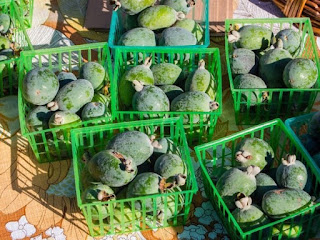Feijoas: Not Only A Beautiful Word But Also A Useful Product
Why feijoas (Acca sellowiana) is a magical fruit. Read her for its use, properties and other nutritional informaiton.
 |
| Feijoa |
Now in the Internet you can find a lot of information about what feijoa is? a very nutritious fruit, having a number of unique nutritional properties in General, and an unusually high content of iodine in particular. Let's see: how this stereotype is true and what are those useful qualities that can be detected in feijoa.
✔ How much iodine in your feijoas?
One of the most valuable quality, Myrtle is considered to be the high content of iodine. In the Internet you can find very conflicting information about the amount of iodine in fresh feijoa.
But in fact, in a truly authoritative sources (e.g., Database, USDA) – there is no data on the content of iodine. This is due to the fact that the presence of iodine in the same product can vary significantly, depending on the growing region.
It is often stated that iodine-rich "the feijoa fruit" grow in coastal regions. And again error! A lot of iodine in those foods that grow in soil are rich in iodine. And the sea has nothing to do with it. For example, even many areas of the coast of the Black sea (a significant part of Crimea, near Odessa) belong to iodine deficiency.
However, in many credible publications, reported about the high iodine content in feijoa, but specific amounts of iodine are indicated in a wide range of values from 0.34 to 35,000 µg / 100 g — that is, data from different sources differ by five orders of magnitude!
✔ Can I use guava to ensure the physiological requirements for iodine?
Insufficient intake of iodine in the human body leads to such diseases as endemic goiter with hypothyroidism, a slow metabolism, arterial hypotension, retarded growth and mental development in children.
- Physiological requirement of iodine for adults is 150 mcg/day.
- Physiological requirement of iodine for children from 60 to 150 mg/day.
If you follow the information on the content of iodine in fresh feijoas at the level of 0.34 mg / 100 g, it turns out that to meet the daily physiological requirement for iodine, you need to eat 44 kg feijoas.
So hardly it is necessary to consider feijoa as a significant source of iodine.
However, if the data on iodine content in feijoa of the most widely quoted source, and is considered reliable data on its content in feijoa fruit at the level of 3000 mg / 100 g, it turns out they have 7 grams of fruit to satisfy the daily human need for iodine. The tolerable upper level of iodine intake can be achieved by eating systematically 20 g of feijoa fruit a day.
In any case, all the sources that describe the nutritional properties of feijoa, come to the conclusion that it is a complete food product, not dangerous for human health.
✔High content of pectin
But the pectin in fresh feijoa fruit contains two times more than in apples, which are traditionally the main source of this valuable material for the production of confectionery products.
In this jam from feijoa cooking is not recommended. All recipes canning imply that fruit just ground sugar, and therefore not subjected to the heat treatment the product can be stored in the refrigerator.
Avoid heat because when it is heated, a significant portion contained in fruits vitamins in varying degrees, destroyed.
More other vitamins are heat-sensitive and have ascorbic acid, when cooking preserves its quantity is reduced 7 times.
Minerals, however, remain in their original number.
✔Feijoa – a powerful antioxidant
"Skin" feijoa sometimes has an astringent taste. This is due to the contained phenolic compounds. But besides these astringent taste these phenolic compounds (such as, for example, catechins and leucoanthocyanins, soluble tannin) possess high biological activity and represent a strong antioxidants.
Canning pineapple guava is also recommended to minimize the oxidation of phenols – that is, to reduce the rate of processed fruit in the open air. This is because, firstly, will allow to keep high P-vitamin activity of the product. And secondly, helps to avoid aesthetic defects such as darkening of the product due to oxidation.











No comments: